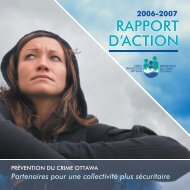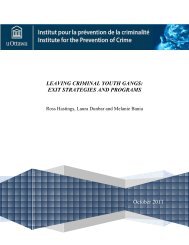Community Crime Prevention: Investing for a Safer Ottawa
Community Crime Prevention: Investing for a Safer Ottawa
Community Crime Prevention: Investing for a Safer Ottawa
Create successful ePaper yourself
Turn your PDF publications into a flip-book with our unique Google optimized e-Paper software.
‣ Youth Inclusion Program<br />
• target the 50 most at-risk youth ages 13-16 living in high-crime neighbourhoods<br />
• provide them with activities ranging from sports and recreational opportunities to<br />
skills training (literacy, anger management, dealing with gangs and drugs)<br />
reduces school expulsions by 27%<br />
reduces youth arrests by 65% and overall crime in neighbourhoods by 16% to<br />
27% 21<br />
‣ <strong>Ottawa</strong> Project Early Intervention<br />
• <strong>for</strong> kids aged 6-12 in two high-risk social housing complexes<br />
• offer skills training, sports and recreation, a homework club, and individualized<br />
counselling and support through a local partnership (police, local orgs and agencies...)<br />
reduces calls <strong>for</strong> service and <strong>for</strong>mal charges by almost 50% in one of the target<br />
housing projects (halfway through its 3-year term) 22<br />
Successes in community design<br />
‣ “Cocoon” Neighbourhood Watch (NW) program to reduce repeat residential burglaries<br />
• create a local multi-agency partnership that includes police and other partners, which<br />
differs from more traditional NW programs run solely by the police 23<br />
• gather neighbours and encouraged them to watch out <strong>for</strong> each others’ property<br />
• improve the physical security of the area, by installing locks and lights, etc.<br />
• work with social and probation services to help high-risk offenders in the<br />
neighbourhood make positive choices<br />
reduces residential burglaries by 41% to 58% after one year, and 75% over four<br />
20 , 24,25<br />
years<br />
‣ <strong>Crime</strong> <strong>Prevention</strong> Through Environmental Design (CPTED)<br />
• reduce the opportunities <strong>for</strong> crime and victimization within the built environment<br />
this is a strong point <strong>for</strong> <strong>Ottawa</strong>: the City uses CPTED principles in its review of<br />
applications <strong>for</strong> the development of public infrastructures 6<br />
• <strong>Ottawa</strong> <strong>Crime</strong>-Free Multi-Housing Program: partnership between Police and<br />
Minto Developments to reduce crime in rental communities<br />
reduces calls <strong>for</strong> service by 70% in some of the 30 certified Minto buildings 26<br />
by integrating these initiatives into a wider, more comprehensive <strong>Ottawa</strong> strategy<br />
<strong>for</strong> community safety, the <strong>Ottawa</strong> approach to crime prevention could be top of the<br />
line.<br />
‣ “Secure Housing by Design”<br />
• provide housing project developers with a CPTED manual and allocate a special<br />
police label of approval <strong>for</strong> housing that meets the various manual criteria<br />
after one year, reduces property crime by 70% <strong>for</strong> participating housing 20 11
















